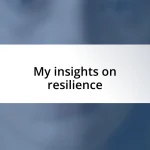Key takeaways:
- Effective storytelling connects emotionally with the audience, evoking empathy and personal reflection.
- Diverse storytelling methods, such as visual aids and interactive elements, enhance engagement and understanding.
- Key elements of storytelling include relatable characters, conflict and resolution, and clear structure, which foster deeper connections.
- Storytelling in business can humanize brands and create emotional bonds, leading to more memorable and impactful communication.

Understanding storytelling effectiveness
Understanding storytelling effectiveness goes beyond just delivering information; it’s about connecting with the audience. I’ve often found that a well-told story evokes emotions, sparking a deeper engagement than mere facts ever could. Have you ever found yourself lost in a tale, feeling each twist and turn? That’s the power of storytelling.
There’s something profoundly transformative about stories. For example, I once attended a workshop where the speaker shared a deeply personal experience. The way he articulated his hardships resonated with many of us, creating a palpable bond in the room. It made me realize how effective storytelling can invoke empathy and make us reflect on our own lives.
Moreover, when we analyze storytelling effectiveness, I notice patterns in what captivates different audiences. I tend to think about my audience’s experiences and values. Are their struggles similar to the ones portrayed in my narrative? This kind of introspection can be the key to crafting a story that not only informs but inspires and drives action.

Importance of storytelling methods
Storytelling methods are essential for effective communication because they help to structure ideas in a way that resonates with the audience. For instance, I remember a time when I presented a project at work. Instead of a straightforward report, I embedded a narrative about a client’s journey. The feedback was overwhelmingly positive; the team felt more connected to the data because they could visualize the impact through the story.
Another vital point is that different storytelling methods cater to diverse audience preferences. In my experience, utilizing visual aids like images or charts alongside narratives can significantly enhance comprehension. I recall a seminar where a speaker alternated between storytelling and visuals, and it kept everyone engaged, making complex themes more accessible and relatable.
Effective storytelling can also drive home ethical and moral considerations in a way that abstract ideas often fail to do. Think about the last powerful movie you watched; it likely moved you because it addressed profound themes through approachable characters. I often reflect on how I can use similar techniques in my own storytelling to challenge my audience’s perception and encourage deeper thinking, while simultaneously evoking emotional responses that prompt action.
| Storytelling Method | Importance |
|---|---|
| Narrative Structure | Helps engage and keeps the audience’s attention by providing a familiar framework. |
| Visual Storytelling | Enhances comprehension and retention of information through images and graphics. |
| Emotional Engagement | Fosters deeper connections and reflections by evoking empathy and personal relevance. |

Key elements of effective storytelling
Effective storytelling hinges on several key elements that can truly make or break a narrative. For instance, I’ve seen firsthand how relatable characters can draw an audience in. A few years ago, during a community workshop, I shared a story about a moment of vulnerability that many attendees had experienced themselves. The connection was instantaneous; people leaned in, nodding along, and I knew I had captured their attention through shared experience.
Here are some fundamental elements I believe contribute to compelling storytelling:
- Relatable Characters: Characters who reflect audience experiences foster empathy.
- Conflict and Resolution: Engaging narratives often involve challenges that lead to transformative outcomes.
- Imagery and Descriptive Language: Vivid descriptions create mental pictures that resonate with the audience.
- Emotional Resonance: Evoking strong feelings helps to cement the message in the audience’s mind.
- Clear Structure: A coherent beginning, middle, and end guide the listener smoothly through the narrative.
Each story has the potential to transport its audience to a different world, but only if the storyteller harnesses these elements effectively. I remember the first time I experimented with building suspense in my narratives. One evening, as I shared a tale around a campfire, I noticed how my pacing changes captivated my friends. Pausing right before the climax had everyone at the edge of their seats, proving that rhythm can amplify effectiveness.

Techniques for engaging an audience
To truly engage an audience, employing varied techniques is essential. One strategy that I’ve found incredibly effective is using interactive elements in my storytelling. For instance, during a recent presentation, I asked the audience to share their own experiences about a similar topic. This not only broke the ice but also made everyone feel included and valued, creating a more vibrant and engaging atmosphere.
Another technique that resonates with me is the art of storytelling through pauses. I distinctly remember telling a personal story in a workshop where I deliberately paused before delivering the punchline. The room fell silent, and I could see the anticipation etched on everyone’s faces. It was a small moment, yet it amplified the impact of what I was about to reveal, drawing everyone in more tightly to my narrative.
Visual storytelling remains a powerful way to captivate an audience. I’ve experimented with this by incorporating short video clips into my talks. Once, I shared a moving clip of a charitable project, showcasing real people impacted by our work. The shift in energy was palpable—the audience felt emotionally connected and invested in the message. It made me realize that a well-placed visual can express what words sometimes struggle to convey. Have you ever thought about how visuals in your storytelling could transform your audience’s experience?

Measuring storytelling impact
Measuring the impact of storytelling can be quite complex, but I’ve found that it often boils down to the audience’s emotional response and engagement level. For example, after presenting a story that intertwined personal challenges with triumph, audience members approached me, eager to discuss their own experiences. Their reactions, filled with genuine emotion, provided a clear indication that my story had resonated with them on a deeper level.
One practical approach I’ve used to gauge storytelling effectiveness is to solicit direct feedback from listeners. Following a workshop where I shared a poignant tale about resilience, I exchanged contact information with participants for follow-up conversations. Their insights often reflect how they felt during the narrative and what parts stood out to them. This has been invaluable; their words help me refine my storytelling techniques and tailor future narratives to better suit audience expectations.
Additionally, I’ve embraced metrics like audience participation and social media engagement to assess storytelling impact. After incorporating a storytelling segment into an event, I noticed an uptick in social media shares and comments. It was exhilarating to see how a personal story could spark discussions online. Have you ever measured your storytelling impact in creative ways, and if so, what did your findings reveal?

Enhancing storytelling with visuals
In my experience, visuals can breathe life into storytelling in ways that words alone often cannot. For example, during one of my talks, I illustrated a complex concept using infographics. The audience’s eyes lit up as data transformed into a compelling visual narrative. It became apparent that visual aids can simplify intricate ideas, fostering better understanding and retention. Don’t you think a well-placed image can sometimes convey an idea more powerfully than a paragraph?
When I began using images that evoke emotions, I noticed a profound shift in audience engagement. During a community event, I displayed a series of powerful images chronicling a local initiative’s impact. The faces of those helped spoke volumes, creating an emotional connection that words struggled to achieve. It was a reminder that visuals don’t just complement stories; they enhance emotional resonance, often striking a chord deep within the audience. Have you tapped into the emotional potential of imagery in your storytelling?
Lastly, I’ve found that incorporating video not only helps illustrate points but also immerses the audience in a story’s atmosphere. I once shared a short documentary clip during a presentation on social justice, and the mood in the room transformed instantly. People were leaning forward, actively engaged with the content rather than passively listening. I realized that using short, impactful videos can act like a narrative catalyst, drawing the audience into the story in an immersive way. Isn’t it fascinating how a moving image can propel a story into realms of connection that plain text often struggles to reach?

Application of storytelling in business
Application of storytelling in business
When I think about the application of storytelling in business, I can’t help but recall a project where we crafted a narrative around our brand’s origin. Instead of presenting dry statistics, we shared the journey of our founder’s struggle and passion for the product. This simple shift made our pitch turn into something memorable; potential clients were not just hearing numbers but feeling a connection. Have you ever considered how a heartfelt story can create an unexpected bond with your audience?
In my own experience, storytelling has been a game-changer during team meetings. Instead of listing sales figures, I shared a customer’s journey with our product, illustrating how it changed their life. The atmosphere shifted; faces lit up with interest, and suddenly, our goals felt more personal, tangible. It’s intriguing how a well-told story can foster camaraderie and make corporate ambitions resonate deeply within our team.
Moreover, I’ve observed that storytelling can effectively humanize a brand. I remember a marketing campaign where we used real testimonials to narrate customers’ experiences. The feedback was astounding! Customers reached out to share their own stories, further amplifying our message. Don’t you think there’s something powerful about seeing a brand through the lens of genuine human experience rather than just a facade?














